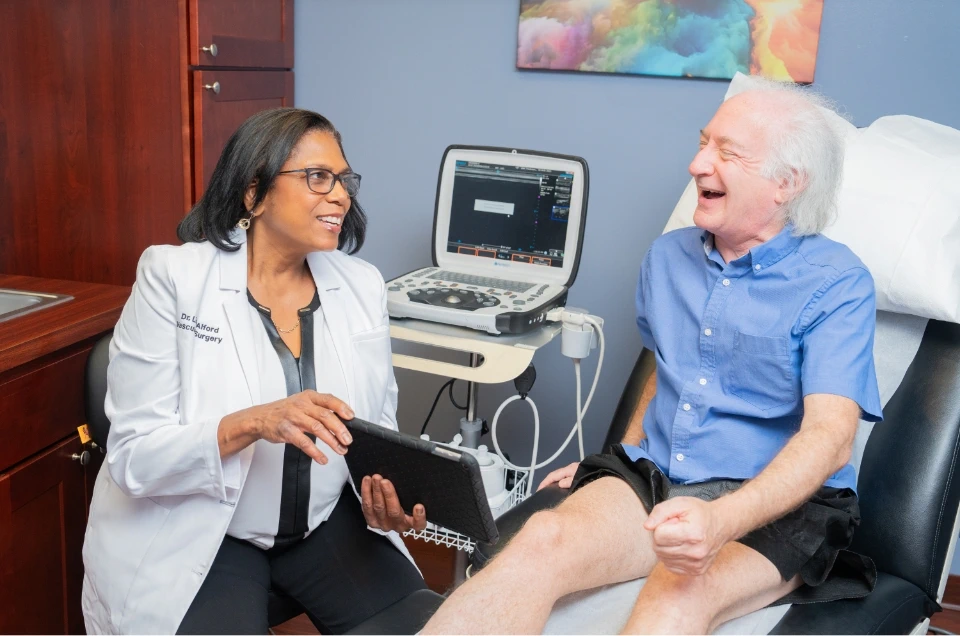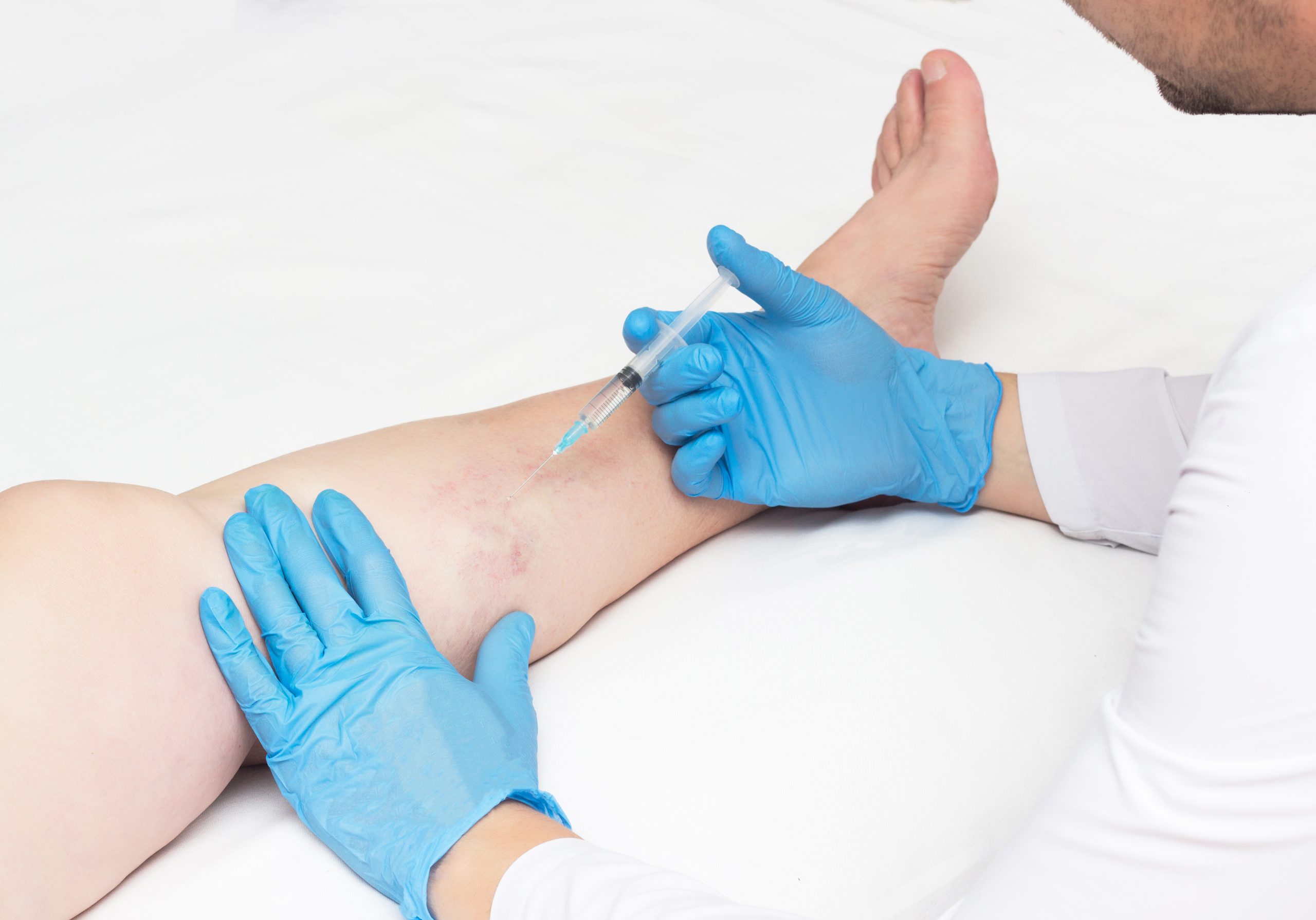Varicose vein treatments have advanced by leaps and bounds in the past three decades. Not too long ago, the only way to treat varicose veins was through complex surgeries that involved incisions, grafting, and all sorts of unpleasant procedures that left you convalescent for days or weeks on end. And after all that, your risk of infections was fairly high, and the chance of success was relatively limited. Well, that’s not the case anymore.
With the development of minimally invasive spider vein and varicose vein treatment options, you can get your annoying (and sometimes dangerous) veins treated or removed in a quick in-and-out procedure. In fact, modern varicose vein treatments are so simple that most patients don’t even take time off work — they simply get the treatment during their work lunch break and then carry on with their day uninterrupted.
This article provides an overview of the top varicose vein treatment options and their pros and cons.

Radiofrequency (RF) Ablation
Radiofrequency (RF) ablation is widely considered one of the best treatments for varicose veins. Your vein doctor numbs your skin to create an incision, which serves as the entry point to a catheter. The vein doctor inserts the catheter into the unhealthy vein under ultrasound guidance, surrounds the vein with an anesthetic fluid, and activates the catheter. It sends sound waves into the diseased vein, collapsing its walls to restore smooth blood circulation to your heart. Radiofrequency ablation is currently the gold standard in varicose vein treatments, and an RF ablation device is a necessity for all vein clinics. Our vein doctors have performed hundreds of successful radiofrequency ablations with no complications.

Pros
- Concludes in 10 to 15 minutes.
- No downtime.
- Causes minimal pain and discomfort.
- Negligible risk of complications.
- Treats the underlying vein disease.
- Nearly perfect track record.
- Covered by insurance plans.
Cons
- None
Endovenous Laser Ablation (EVLT)
Endovenous laser ablation (EVLT) is similar to radiofrequency ablation, except it uses laser energy instead of sound waves. The vein doctor administers local anesthesia to insert a small device into the diseased saphenous vein under ultrasound guidance. Once the catheter or laser fiber is within the unhealthy vein, the vein doctor surrounds it with a numbing solution and activates the device. The laser energy collapses the saphenous vein’s walls, rerouting the accumulated blood to healthier veins. EVLT is widely considered the gold standard in varicose vein treatments — your vein doctor will assess your condition and medical history to determine if you’re a better candidate for endovenous laser or radiofrequency ablation.
Pros
- Concludes in 10 to 15 minutes.
- No downtime.
- Negligible risk of complications.
- Treats the underlying vein disease.
- Nearly perfect track record.
- Covered by insurance plans.
Cons
- Causes more post-procedural discomfort than radiofrequency ablation.
VenaSeal
VenaSeal is one of the latest technologies for treating varicose veins. VenaSeal is essentially a medical-grade adhesive (or vein glue) that’s injected into the unhealthy saphenous vein under ultrasound guidance. The vein glue seals the vein’s walls, and the accumulated blood flows to healthier veins. VenaSeal is a relatively new procedure, and its long-term effects aren’t yet conclusive, but it may be the recommended treatment if your vein doctor determines it’s a suitable path for you.
Pros
- Painless and comfortable.
- Only involves an injection.
- Quick in-and-out treatment.
- Negligible risk of complications.
- Treats the underlying vein disease.
Cons
- Long-term effects are unclear.
- Relatively new procedure.
- Not covered by some insurance plans.
ClariVein (Chemical Ablation)
ClariVein, also known as chemical ablation, is an advanced technology that enters and collapses the diseased vein internally. The device features an innovative 360-degree rotating tip that allows the vein doctor to deliver the vein fusion fluids without laser or thermal energy. This procedure is specifically useful when the underlying diseased saphenous vein follows a twisted or knotted path. Our vein doctors examine your saphenous veins and medical history to determine if you’re a viable candidate for a ClariVein treatment.
Pros
- Effectively closes the diseased varicose veins.
- Minimally invasive procedure.
- Painless and comfortable.
- Minimal side effects.
- Concludes within 30 minutes.
- No downtime.
- Treats the underlying vein disease.
Cons
- Not covered by some insurance plans.
- More time consuming than RFA.
Hypertonic Saline
Hypertonic saline is one of the oldest treatments for spider veins. During this procedure, the vein doctor injects concentrated salt water (hypertonic saline) into the spider veins to make them shrink and close down.
Pros
- Effectively shrinks the spider veins.
- Good track record.
- Minimally invasive procedure.
Cons
- Uncomfortable and painful experience.
- Only treats the visible spider veins — not the underlying vein disease.
- Not as effective as more modern sclerotherapy options.
Sclerotherapy with Varithena
Sclerotherapy with Varithena, also known as foam sclerotherapy, is a minimally invasive procedure wherein a special pre-mixed foam solution is delivered into the affected spider veins and varicose veins under ultrasound guidance. The treatment is combined with a special nitrogen infusion to make it work faster and more effectively. Our vein doctor carefully assesses your condition to determine if you’re a suitable candidate for sclerotherapy with Varithena.
Pros
- Effectively treats small and large spider veins and varicose veins.
- Non-surgical and minimally invasive procedure.
- Minimal pain and discomfort with minimal side effects.
- Negligible risk of complications.
- No downtime.
- Faster and more effective than traditional sclerotherapy.
Cons
- None.
Sclerotherapy with Polidocanol
Sclerotherapy with polidocanol is a minimally invasive treatment wherein a polidocanol solution is used to make your spider veins shrivel and close down. The vein doctor injects the polidocanol solution into the spider veins to fuse their vein walls, essentially turning them into scar tissues that get absorbed by the body and fade away.
Pros
- The ideal treatment for spider veins.
- Nearly perfect success rate.
- Painless and comfortable.
- No downtime.
- Negligible risk of complications.
Cons
- Only treats the visible spider veins — not the underlying vein disease.
Laser for Spider Veins
Laser for spider veins is a simple procedure used by medical spas and dermatologists. The doctor directs laser light at the spider veins to make them shrivel up and fade away. However, laser for spider veins is a superficial treatment that may temporarily reduce the visibility of spider veins without addressing the root cause. Laser treatment is generally used for spider veins on the face or feet.
Pros
- Safely treats spider veins on the face or feet.
- Reduces the visibility of spider veins.
- No incisions or injections necessary.
- Completely safe.
- No downtime.
- No pain or discomfort.
Cons
- Incapable of making a lasting difference.
- Doesn’t treat the underlying vein disease.
- High chance of the spider veins returning.
Spider Veins & Varicose Veins FAQs
What causes varicose veins?
Spider veins and varicose veins are dense clusters of blood vessels visible on the skin’s surface or bulging out in thick, dense masses. They’re usually caused by underlying venous insufficiency, a medical condition wherein the veins under the skin’s surface don’t function correctly. They can’t effectively carry blood towards the heart, causing blood to pool in your leg veins. The increased pressure leads to the dilation of your vein valves, leading to protruding varicose veins.
What are varicose veins risk factors?
Varicose veins risk factors include obesity, pregnancy, use of birth control pills, a family history of vein disease, age, a history of blood clots, or a sedentary lifestyle with minimal activities and exercise.
Do you get spider veins during pregnancy?
The risk of spider veins increases significantly during pregnancy. The added weight of the fetus in the uterus places greater pressure on the veins, increasing the risk of blood accumulation in your leg veins. However, spider veins during pregnancy generally fade away after giving birth.
Does crossing your legs give you spider veins?
Crossing your legs doesn’t give you spider veins. However, you have a higher risk of getting spider veins and varicose veins if you sit still for long periods (with or without crossed legs) because that increases the chance of blood accumulation in your leg veins.
Can you treat varicose veins in the butt?
Varicose veins often appear on the thighs or buttocks. If so, varicose veins in the butt can be treated using the procedures mentioned earlier. Your vein doctor will examine the varicose veins to determine the ideal varicose vein treatment option.
How to not get spider veins?
There’s no means of ensuring you don’t get spider veins. They can happen due to various underlying factors, many of which you don’t have any control over, such as your biological sex or family history. However, you can reduce the risk of spider veins by wearing compression stockings, exercising, and walking frequently.
Choosing the Best Varicose Vein Treatment Option
Numerous factors must be considered when choosing the best varicose vein treatment for your specific needs, such as your family history, medical history, allergies, symptoms, and the results of your vascular imaging.
At Vein Treatment Clinic, our exceptional board-certified vein doctors patiently examine your varicose veins and run the appropriate diagnostic tests to curate the ideal varicose vein treatment plan. If you have spider veins, leg pains, frequent leg cramps, or other symptoms of vein disease, please schedule an appointment with one of our state-of-the-art vein centers in New York, New Jersey, California, or Texas.








